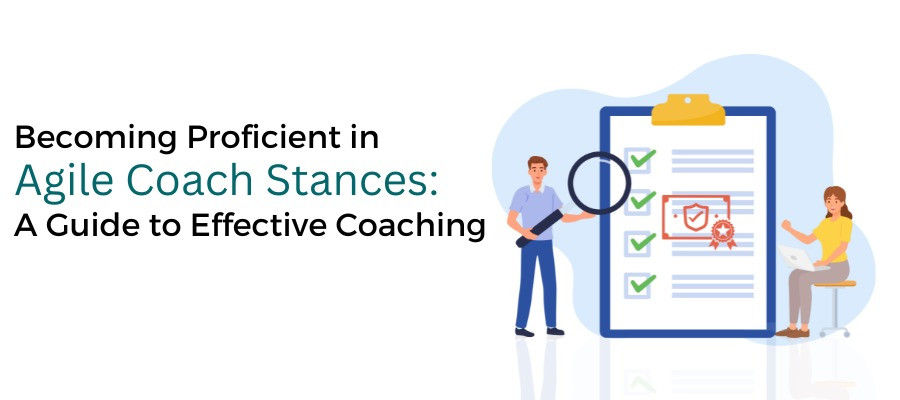Becoming Proficient in Agile Coach Stances A Guide to Effective Coaching

Have you ever wondered what it takes to become a proficient Agile Coach? In 2023, Agile Practices have become a cornerstone for successful Software Development. But mastering Agile goes beyond just following the methodologies – it requires embodying different stances that help guide teams toward excellence. Let's delve into Agile Coach stances and discover how they can lead to effective coaching without losing sight of the broader picture.
Diverse Agile Coach Stances and Their Applications:
Agile coach stances encompass a spectrum of roles. Agile coaches adopt while engaging with teams and individuals. Each stance demands unique skills and approaches for efficacy. This segment delves into the array of Agile coach stances and their practicality in various coaching contexts.
- Counselor Stance: The Counselor Stance embodies active listening and empathy. Agile coaches utilizing this stance guide individuals in exploring thoughts, emotions and finding resolutions. Ideal for aiding team members grappling with interpersonal issues or adapting to change.
- Coach Stance: Coach Stance focuses on skill enhancement. With this stance, the Agile Coach can help individuals formulate plans for progress. Valuable when aiding individuals striving for skill improvement or surmounting hindrances.
- Partner Stance: Partner stance thrives on collaboration and shared objectives. Agile coaches and teams collaboratively tackle challenges, ensuring collective success. Aids teams navigating intricate projects necessitating high-level teamwork.
- Facilitator Stance: The Facilitator Stance guides and supports group endeavors. Agile coaches facilitate efficient meetings and discussions, ensuring inclusivity and collaborative decision-making. Suited for teams grappling with communication or decision-making.
- Teacher Stance: The Teacher Stance imparts instruction and guidance. Agile coaches offer training and workshops for grasping Agile principles and practices. Beneficial for newcomers to Agile or when introducing new practices.
- Modeler Stance: Modeler stance exemplifies leadership through action. Agile coaches demonstrate desired behavior, encouraging team members to follow suit. Effective for teams embracing Agile practices or adopting new ones.
- Observer Stance: Observer Stance involves watching and providing feedback. Agile coaches observe behavior, offer constructive feedback, and celebrate achievements. Valuable for teams needing improved communication or collaboration.
- Advisor Stance: Advisor stance offers guidance and advice. Agile coaches advise on best practices and potential pitfalls, aiding teams in applying Agile principles effectively. Valuable for enhancing Agile practices or addressing challenges.
- Expert Stance: Expert stance provides specialized knowledge. Agile coaches with expertise in specific domains guide teams to approach complex problems. Beneficial for technical hurdles or knowledge gaps.
The Significance of Agile Coach Stances:
Agile coach stances are pivotal in steering successful Agile integration within organizations. They demand a profound comprehension of diverse stances and their applications in different coaching scenarios. Here is how they influence organizational dynamics.
Adapting Swiftly to Changing Realities:
Agile Coach stances offer a distinct advantage - The ability to adjust to an organization's ever-shifting landscape. Navigating situations requires Agile Coaches to gauge and choose the most fitting stance. For instance, the teaching stance might prevail during early Agile Adoption, while the mentoring stance finds its place in more advanced stages.
Enhancing Collaboration and Empowerment:
Agile Coach stances foster a culture of collaboration and empowerment within teams. Adopting a facilitative stance, Agile Coaches nurture teamwork toward collective accomplishments. Facilitating dialogues and brainstorming sessions propels a culture of collaboration and empowerment.
Elevating Coaching Efficacy:
Agile Coach stances wield significant influence over coaching effectiveness. Agile Coaches proficient in varied stances excel in guiding both individuals and teams. The coaching stance, for instance, refines individual skills, while the consulting stance provides targeted guidance.
How Can An Agile Practitioner Develop The Agile Coach Stances?
An Agile Coach requires extensive Training to develop the previously-discussed Agile coach stances. Let’s explore different approaches for developing the Agile Coach Stances:
Acquiring Leadership Qualities:
An Agile Coach must have the qualities of an Agile Leader. He must have the following habit to excel in Agile Coaching:
- Active Listening: Understand the team members' concerns and address them effectively.
- Observation: Keenly observe team dynamics to identify improvement areas and guide the teams accordingly.
- Problem-solving skills: An Agile Coache must promote innovation and creative ideas of team members.
- Continuous Learning: Agile is ever-evolving, and Agile Coaches must stay updated with the latest practices
With these habits, an Agile Practitioner can develop the habit of an Agile Leader. Eventually, it will help him become the best Agile Coach for the team.
Continuous Learning and Building Practical Skills:
An Agile Coach must train himself to develop a strong foundation of various Agile theories and methodologies. Hence, he should understand the core Agile coach stances and practice to acquire the stances. It helps the Agile Coache to garner practical knowledge about different Agile Practices.
However, Agile Coach Training needs to be a continuous process. The Agile Practitioner must continue Learning Agile methodologies with Workshops and Training. Once the Agile Practioner develops the core stances of an Agile Coach, it will help him shine as an Agile Leader.
Conclusion
Becoming proficient in Agile Coach stances is a continuous learning and adaptation journey. Agile Coaches guide teams toward a culture of collaboration, innovation, and adaptability by embodying various stances such as enabler, mentor, and catalyst for change. These stances – facilitator, teacher, and coach – offer a versatile toolkit for Agile Coaches to support teams effectively. By cultivating Active Listening, Empathy, and Continuous Learning, Agile Coaches become invaluable assets in steering teams toward success. Remember, Agile coaching is not just about following practices; it's about embodying the Agile mindset and helping teams unleash their full potential. So, are you ready to embark on your journey to becoming a proficient Agile Coach?
Reference
- https://www.scrum.org/resources/blog/3-steps-becoming-agile-coach



